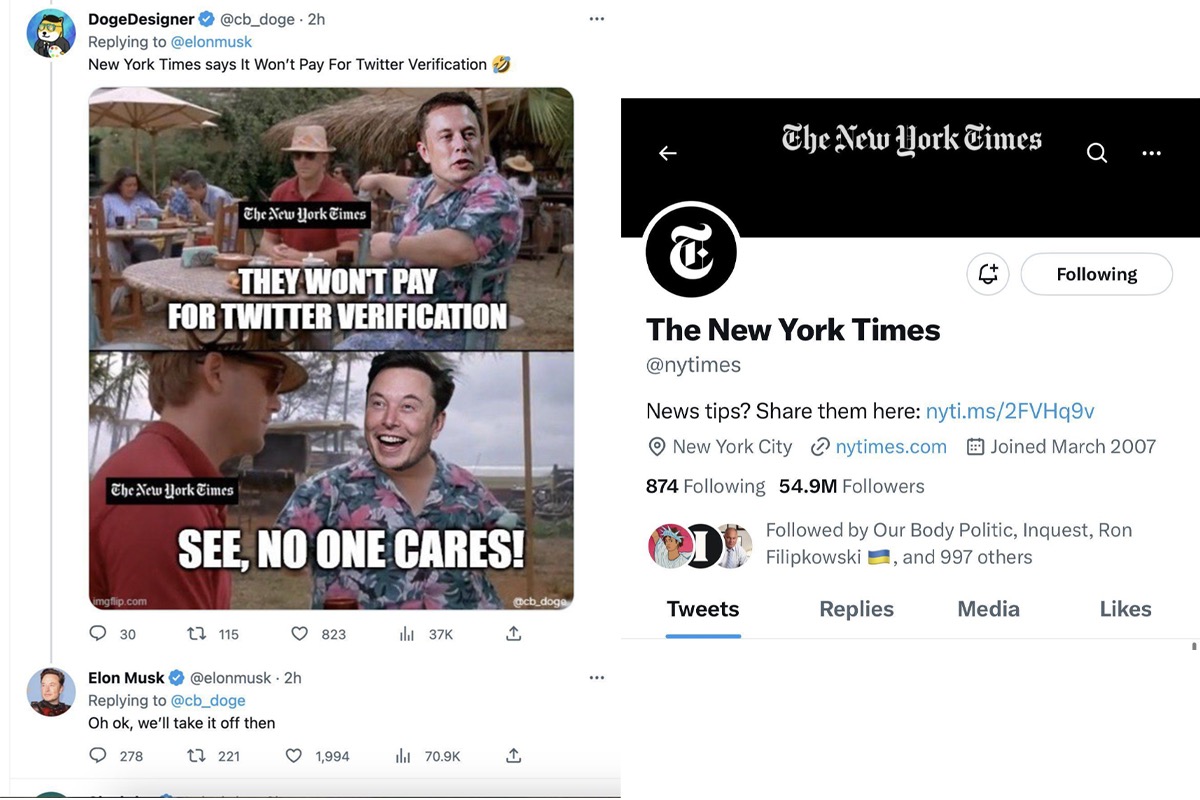The New York Times, a leading American newspaper, has been stripped of its verified blue check mark on Twitter after announcing that it would not pay for Elon Musk’s new subscription-based verification system. The move is set to bring catastrophic changes in the way media organisations have used Twitter’s reach to grow their unchecked business and creating a vitiated atmosphere to influence government.
This came after Twitter announced that it would begin removing its “legacy” verification checks from April 1st. The New York Times’ main account, which has a massive following of 54.9 million, was the only verified account to lose its check mark.
Twitter CEO, Elon Musk, tweeted that the publication’s page would lose the verification symbol, which is the only public indicator of an account’s legitimacy, after The New York Times announced it would not pay for verification. Musk’s response was triggered by a tweet from a user named DogeDesigner, who posted that the Times wouldn’t pay for Twitter verification. In response to that tweet, Musk said, “Oh ok, we’ll take it off then.” He then followed up with two tweets criticizing The New York Times’ reporting, one of which called it “propaganda,” and the other likened the newspaper’s Twitter feed to “diarrhea.”
However, other Twitter accounts of the Times, including New York Times World, NYT Science, and New York Times Opinion, retained their verified check marks.
According to a report by CNN’s Oliver Darcy earlier this week, The New York Times declined to pay the monthly fee for verification of its institutional Twitter accounts. A spokesperson for the publication was quoted as saying, “We aren’t planning to pay the monthly fee for verification of our institutional Twitter accounts.”
The New York Times has announced that it will not pay for its journalists’ personal Twitter accounts to be verified, except in rare cases where verification is deemed essential for reporting purposes. A spokesperson for the publication stated that they would not reimburse reporters for the verification of personal accounts.
This comes after Twitter announced that it would remove its “legacy” verification badges from April 1st. Twitter has introduced new rules, under which organizations can apply for a new “gold” verification badge, while individuals must subscribe to Twitter Blue, costing £11 per month. Twitter Blue subscribers will receive access to additional features such as longer tweets, the ability to edit posts, higher prioritization in the algorithm, and the coveted blue verification badge.
Critics have raised concerns about the new verification system, with some arguing that it increases the risk of imposters spreading false information on the platform. However, Twitter has defended the changes, stating that they are intended to make the verification process more transparent and accessible.
NYT’s decisions come at a time when the White House has reportedly decided against paying for the verification of its staff’s official Twitter profiles. This development was reported by Axios, which cited an email sent to staffers by White House Director of Digital Strategy, Rob Flaherty, on Friday afternoon.
The email reportedly stated that Twitter Blue, the platform’s paid subscription service, does not offer person-level verification as a service. Therefore, a blue checkmark on a profile will now merely serve as verification that the account belongs to a paid user.
This decision by the White House comes amid Twitter’s recent changes to its verification system, which has introduced a new “gold” verification badge for official organizations. However, individuals are required to pay for Twitter Blue subscription to access new tools such as longer tweets, the ability to edit posts, and higher prioritization in the algorithm, in addition to a blue verification badge.










